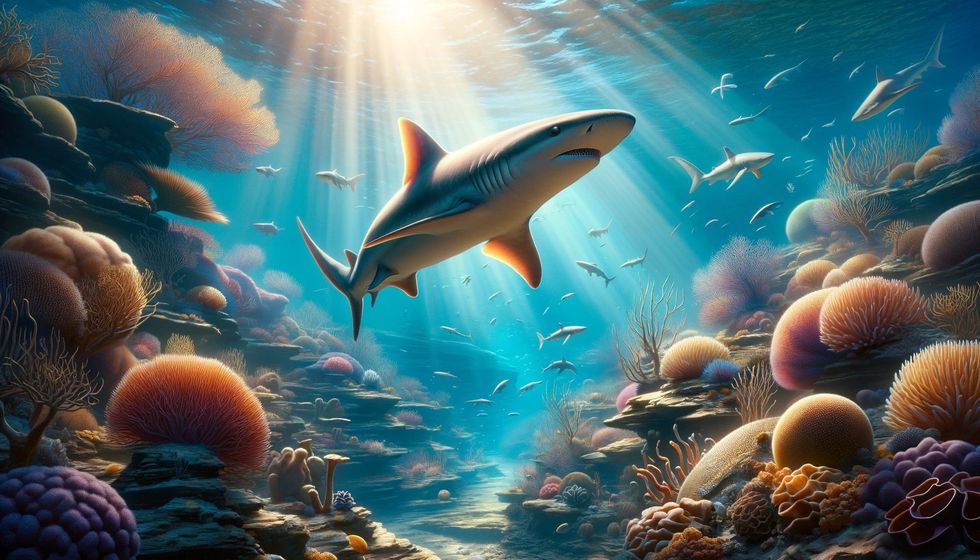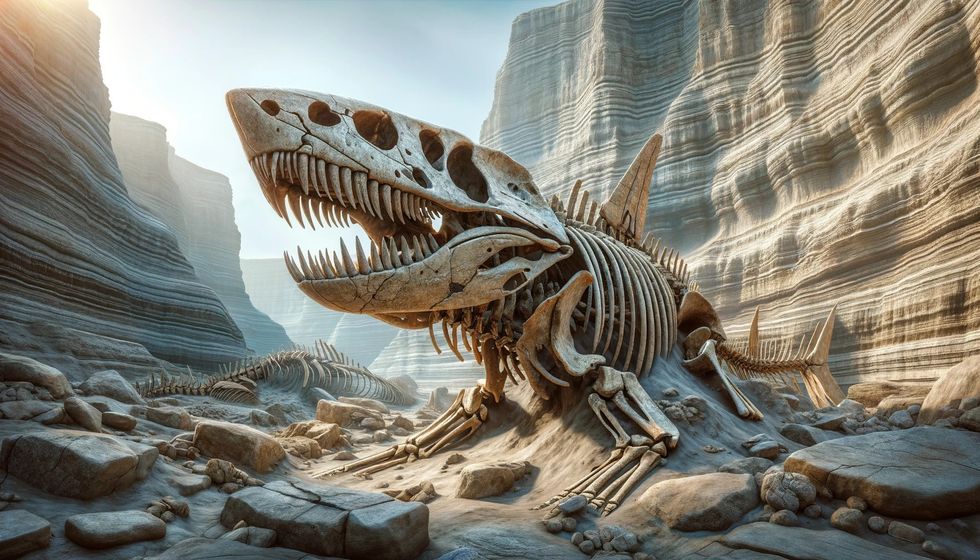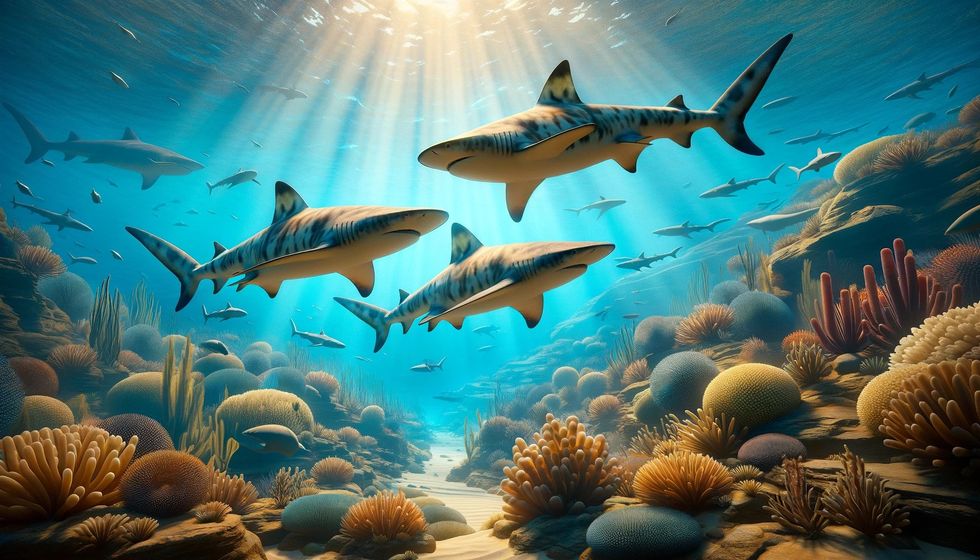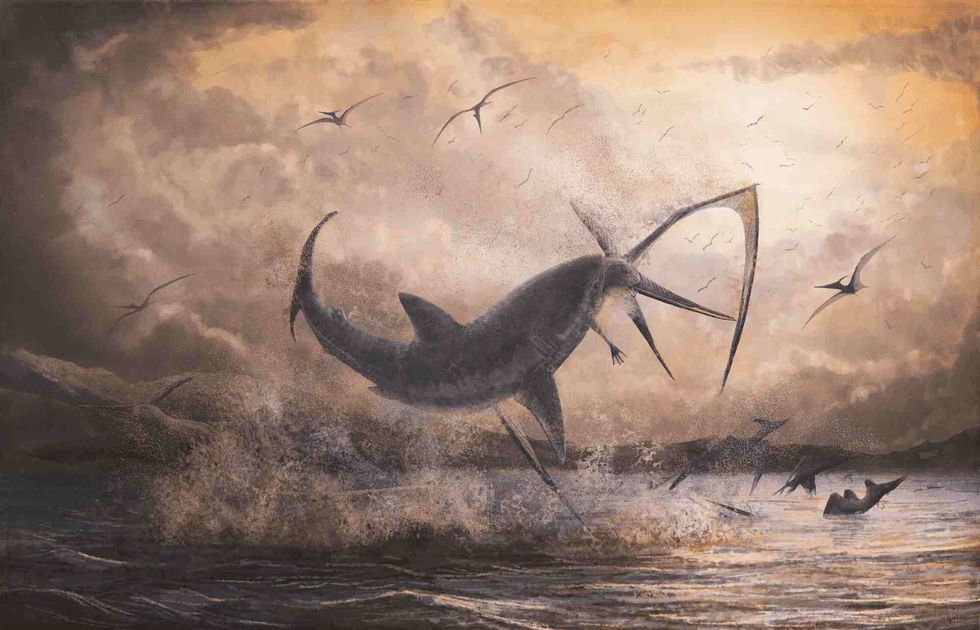Fun Cretoxyrhina Facts For Kids

Cretoxyrhina mantelli, widely recognized as the Ginsu Shark, ranked among the top predators in marine ecosystems during the Late Cretaceous Period (about 100.5-66 million years ago). Despite an often sparse fossil record, the remains found, including a partial but revealing collection of calcified elements beyond just teeth, provide valuable insights into the existence of this paramount lamniform shark.
With a specialized dentition featuring anterior teeth for securely grasping prey and larger, serrated posterior teeth on both the upper jaw and lower jaw for cleaving flesh, this shark was well-equipped for its role as an apex predator.
These teeth, unearthed in more complete skeletons, reveal a shark with cutting abilities that draw parallels to the hunting strategies employed by many sharks, including those that are fast-swimming like the modern great white.
Although typically placed within its family, Cretoxyrhinidae, the possibility of other taxonomic placements has been discussed, highlighting the varied and complex nature of shark evolution. The combination of skeletal features and powerful jaws provides a testament to the Ginsu Shark's status as a formidable hunter that dominated the prehistoric oceans.
Cretoxyrhina Interesting Facts
How do you pronounce 'Cretoxyrhina'?
The name 'Cretoxyrhina' is pronounced as 'Cre-TOX-y-rhi-na'.
What type of dinosaur was a Cretoxyrhina?
Cretoxyrhina mantelli wasn't a dinosaur but one of the largest sharks that roamed the Late Cretaceous seas.
In which geological period did the Cretoxyrhina roam the Earth?
The temporal range of the Cretoxyrhina was during the Late Cretaceous Period (about 100.5-66 million years ago).
When did the Cretoxyrhina become extinct?
Cretoxyrhina mantelli is believed to have become extinct during the Late Cretaceous Period (around 73 million years ago).
Where did Cretoxyrhina live?

The Cretoxyrhina exhibited a widespread distribution, with its fossils discovered in various locations across the globe, including North America, Europe, Israel, and Kazakhstan. This species inhabited the marine ecosystems of temperate to subtropical pelagic oceans, showing a particular abundance in the area of the Western Interior Seaway, encompassing what is now the central United States and Canada.
Cretoxyrhina fossils have been unearthed in multiple locations, with Kansas being among the notable areas of discovery.
What was the Cretoxyrhina's habitat?
The Cretoxyrhina thrived in marine environments, from shallow coastal margins to deeper sea waters.
Who did a Cretoxyrhina live with?
In the marine ecosystems of the Late Cretaceous Period, the Cretoxyrhina existed alongside a host of other marine entities including, but not limited to, mosasaurs, plesiosaurs, the hefty Xiphactinus fish, and the immense mosasaur Tylosaurus, which posed a predatory threat to the Cretoxyrhina itself. Moreover, contemporaneous smaller sharks like Squalicorax often fed on the remnants of Cretoxyrhina.
How long did a Cretoxyrhina live?
Research utilizing vertebrae from skeletal remains has permitted the estimation of Cretoxyrhina's life history, with projections indicating a lifespan that could span close to 40 years.
How did the Cretoxyrhina reproduce?

It is thought that the Cretoxyrhina utilized an ovoviviparous mode of reproduction, wherein embryos mature within the mother's body and hatch when fully developed.
Cretoxyrhina Fun Facts
What did a Cretoxyrhina look like?
The Cretoxyrhina was a large shark with a streamlined body and dense, thick enamel on its teeth. Its most spectacular feature was its lethal teeth, ideal for shearing through flesh and bone.
How many bones did a Cretoxyrhina have?

Ascertaining the total bone count in Cretoxyrhina is complicated due to the fossil record's emphasis on its plentiful, durable teeth and the less fossilizable cartilaginous nature of its skeleton. With scientific exploration, more details about Cretoxyrhina's skeletal framework may be revealed.
How did Cretoxyrhina communicate?
The communication methods employed by the Cretoxyrhina are currently not documented within the scientific community. As research progresses, future findings may offer insight into how these ancient sharks interacted with their environment and each other.
How big was a Cretoxyrhina?
Cretoxyrhina mantelli grew up to 23-26 ft (7-8 m) in length, making it one of the largest sharks of the Cretaceous oceans.
How fast could a Cretoxyrhina swim?
The Cretoxyrhina ranked as one of the fastest sharks in the water, with studies on its hydrodynamics indicating that it could achieve speeds reaching 70 kmh (43 mph). The predator may have employed a strategy of swift lunging attacks, comparable to the hunting tactics of the modern great white shark, delivering forceful strikes to its prey.
It is thought that the Cretoxyrhina depended heavily on acute vision for these high-speed pursuits.
How much did a Cretoxyrhina weigh?
Estimates based on the size of known specimens suggest that the Cretoxyrhina could have weighed up to 10900 lb (4944 kg).
What were the male and female names of the Cretoxyrhina?
There are no specific names for male and female Cretoxyrhina mantelli; they are referred to by their scientific names.
What would you call a baby Cretoxyrhina?
A baby Cretoxyrhina would be called a pup or juvenile, as is the case with modern sharks.
How aggressive were the Cretoxyrhina?
The Cretoxyrhina, known among paleontologists as cartilaginous Ginsu sharks, were indubitably apex predators of their era. While they are seen as fierce and formidable, concrete evidence detailing their precise hunting practices and levels of aggression remains elusive. It is anticipated that continued paleontological studies will provide a deeper understanding of these facets of their behavior.
Did You Know...

Unique fossil evidence, such as bite marks on large prey like the giant mosasaur and teeth embedded in their fossils, provides a glimpse into the paleoecological relationships of Cretoxyrhina with other marine animals.
Examination of Cretoxyrhina skeletal remains indicates that the shark had facial and visual characteristics closely resembling those found in thresher and crocodile sharks. Its streamlined physique implies that it may have utilized regional endothermy to regulate its body temperature.
Traditionally classified within its own unique family, Cretoxyrhinidae, Cretoxyrhina is regarded as the likely sole member, of this group. However, alternative taxonomic placements have been suggested, with some theories proposing its inclusion in families such as Alopiidae and Lamnidae.
The name Cretoxyrhina melds 'creto', a nod to the Cretaceous Period, with 'Oxyrhina', a term spun from the Greek words for 'sharp' (ὀξύς) and 'nose' (ῥίς), suggesting the meaning 'Cretaceous sharp-nose'. However, this shark is thought to have had a more rounded snout.
The specific name 'mantelli' pays homage to Gideon Mantell, an English paleontologist who provided the species' original specimens, as named by Louis Agassiz.
For the species 'denticulata', the name borrows from Latin, with 'denticulus' referring to 'small tooth' and 'āta' indicating possession, highlighting the lateral cusps characteristic of this species' dentition. 'Vraconensis', meanwhile, traces its etymology to the Vraconian substage of the Albian, marking where it was discovered.
The species name 'agassizensis' is tied to Lake Agassiz, the site of discovery, which itself is dedicated to Louis Agassiz. 'Ginsu shark', a term coined in 1999 by paleontologists Mike Everhart and Kenshu Shimada, likens the species' theorized predatory tactics to the efficient cutting action of a Ginsu knife.
The numerous Cretoxyrhina mantelli teeth unearthed by Mike Everhart from the Late Cretaceous sediments located in the western region suggest the past prevalence of this shark in the area.
These teeth, reminiscent of a mako shark's yet thicker and sturdier with a robust enameloid covering, were undeniably suited for capturing and consuming large, nimble, and defensively equipped marine creatures. Evidence such as distinctive bite marks and teeth still lodged in bone fragments of its prey suggests Cretoxyrhina chomped with immense strength and lethal impact.
The theoretical feeding mechanism of Cretoxyrhina mantelli, the type species often called the Ginsu Shark, draws comparisons to the efficient slicing and dicing action of the Ginsu knife, thus inspiring its popular nickname. Existing data and evidence suggest Cretoxyrhina fed on various formidable marine creatures, including mosasaurs, plesiosaurs, and even the immense predatory fish known as Xiphactinus.
The skeletal anatomy of most Cretoxyrhina specimens can be reconstructed primarily from fossilized teeth and vertebrae. Being cartilaginous fish, Cretoxyrhina's skeletons were composed of cartilage rather than bone, which typically does not fossilize as readily.
Nonetheless, remarkable specimens of Cretoxyrhina mantelli (C. mantelli), particularly from the Niobrara Formation, have been found with extraordinary preservation. This is attributed to the formation's chalk-rich calcium that facilitated a process known as calcification, causing soft tissue to solidify and, consequently, become more susceptible to fossilization.
In the late '00s, many species were initially labeled as distinct from Cretoxyrhina mantelli by paleontologists, but later research grouped them under the same species name. At one point, nearly 30 different synonyns for O. mantelli were proposed based on various teeth fossils. These teeth showed slight variations when compared to the original syntypes of C. mantelli.
For instance, Henri Sauvage, a French paleontologist, found teeth in France in 1870 that closely matched the O. mantelli ones from England, yet they bore additional features such as lateral cusplets, leading him to ascribe them to a new species, Otodus oxyrinoides.
Similarly, in 1873, Joseph Leidy, an American paleontologist, came across teeth in Kansas and Mississippi that were heftier and wider than the English syntypes, prompting him to classify these findings under a different species, Oxyrhina extenta. Over time, however, these discoveries were all folded into the understanding of Cretoxyrhina mantelli's variability.
FAQs
Why did Cretoxyrhina go extinct?
The precise factors leading to the extinction of Cretoxyrhina remain shrouded in mystery due to the incomplete fossil record. It is theorized that the emergence of formidable competitors, like the large mosasaurs, could have posed a significant threat to the Cretoxyrhina, potentially even preying upon them. Additionally, shifting prey populations and environmental changes might have played a role in their decline. However, these hypotheses are speculative, and further paleontological research is necessary to shed definitive light on the true causes of the disappearance of this ancient shark species.What did Cretoxyrhina look like?
The Ginsu Shark, commonly referred to as Cretoxyrhina mantelli, was an imposing figure in its marine habitat, reaching lengths of approximately 23-26 ft (7-8 m). This shark bore a striking resemblance to today's great white shark, both in appearance and physical structure, according to fossil records. During its reign, Cretoxyrhina ranked among the ocean's largest predatory sharks.
Is a Cretoxyrhina a reptile?
The Cretoxyrhina was not a reptilian creature but rather a type of mackerel shark. It belonged to the Chondrichthyes class and the Elasmobranchii subclass, a category that encompasses both sharks and rays.
What are some interesting facts about Cretoxyrhina?
As a top predator, the Cretoxyrhina occupied a vital niche within the oceanic environments where it resided. This widespread genus had a global presence, with an abundance of its fossils unearthed especially within the Western Interior Seaway of North America.
Research conducted on the vertebrae from several skeletons has shed light on its growth patterns and life cycle.
The Ginsu Shark exhibited a rapid growth rate in its juvenile years and attained maturity relatively quickly, around the age of four to five. It is estimated that Cretoxyrhina could have enjoyed a lifespan of close to 40 years.
Cretoxyrhina mantelli, a Late Cretaceous lamniform shark, embodies a rich and detailed panorama of the ecosystems from that epoch. Recognized in vertebrate paleontology as one of the grandest sharks of its era, its existence marked the prominence of an apex predator with the capacity to subdue large oceanic fauna.
Characterized by its bone-shearing Cretoxyrhina teeth and theorized behavioral patterns, this age-old shark continues to intrigue and enhance the knowledge of marine biology during the Cretaceous Period and the evolutionary lineage of sharks.
- Fun Rhomaleosaurus Facts For Kids ›
- Fun Kaiwhekea Facts For Kids ›
- Fun Helicoprion Facts For Kids ›
- Fun Xiphactinus Facts For Kids ›
- Fun Hypohippus Facts For Kids ›
We Want Your Photos!
More for You
Sources
https://www.nationalgeographic.com/animals/facts/cretoxyrhina
https://en.wikipedia.org/wiki/Cretoxyrhina
https://carnivora.net/cretoxyrhina-mantelli-t282.html
http://www.prehistoric-wildlife.com/species/c/cretoxyrhina.html
Bachelor of Science specializing in Nautical Science

Ayan BanerjeeBachelor of Science specializing in Nautical Science
Thanks to his degree in nautical science from T.S. Chanakya, IMU Navi Mumbai Campus, Ayan excels at producing high-quality content across a range of genres, with a strong foundation in technical writing. Ayan's contributions as an esteemed member of the editorial board of The Indian Cadet magazine and a valued member of the Chanakya Literary Committee showcase his writing skills. In his free time, Ayan stays active through sports such as badminton, table tennis, trekking, and running marathons. His passion for travel and music also inspire his writing, providing valuable insights.
Bachelor of Arts specializing in English and Drama, Master of Arts specializing in Performance: Design and Practice

Luca DemetriouBachelor of Arts specializing in English and Drama, Master of Arts specializing in Performance: Design and Practice
Experienced in writing and sub-editing, Luca holds a Bachelor's in English Literature and Drama from the University of Birmingham, where he served as the culture editor at Redbrick Paper. He is currently pursuing a Master's in Performance: Design and Practice at the University of the Arts in London, showcasing his passion for the arts, performance, and history. With a keen interest in traveling, Luca enjoys exploring new cultures and experiencing diverse perspectives.
Disclaimer
1) Kidadl is independent and to make our service free to you the reader we are supported by advertising. We hope you love our recommendations for products and services! What we suggest is selected independently by the Kidadl team. If you purchase using the Buy Now button we may earn a small commission. This does not influence our choices. Prices are correct and items are available at the time the article was published but we cannot guarantee that on the time of reading. Please note that Kidadl is a participant in the Amazon Services LLC Associates Program, an affiliate advertising program designed to provide a means for sites to earn advertising fees by advertising and linking to Amazon. We also link to other websites, but are not responsible for their content.
2) At Kidadl, we strive to recommend the very best activities and events. We will always aim to give you accurate information at the date of publication - however, information does change, so it’s important you do your own research, double-check and make the decision that is right for your family. We recognise that not all activities and ideas are appropriate for all children and families or in all circumstances. Our recommended activities are based on age but these are a guide. We recommend that these ideas are used as inspiration, that ideas are undertaken with appropriate adult supervision, and that each adult uses their own discretion and knowledge of their children to consider the safety and suitability. Kidadl cannot accept liability for the execution of these ideas, and parental supervision is advised at all times, as safety is paramount. Anyone using the information provided by Kidadl does so at their own risk and we can not accept liability if things go wrong.
3) Because we are an educational resource, we have quotes and facts about a range of historical and modern figures. We do not endorse the actions of or rhetoric of all the people included in these collections, but we think they are important for growing minds to learn about under the guidance of parents or guardians.







